The Cambridge History of China. Vol. 13: Republican China 1912-1949, Part 2
Подождите немного. Документ загружается.

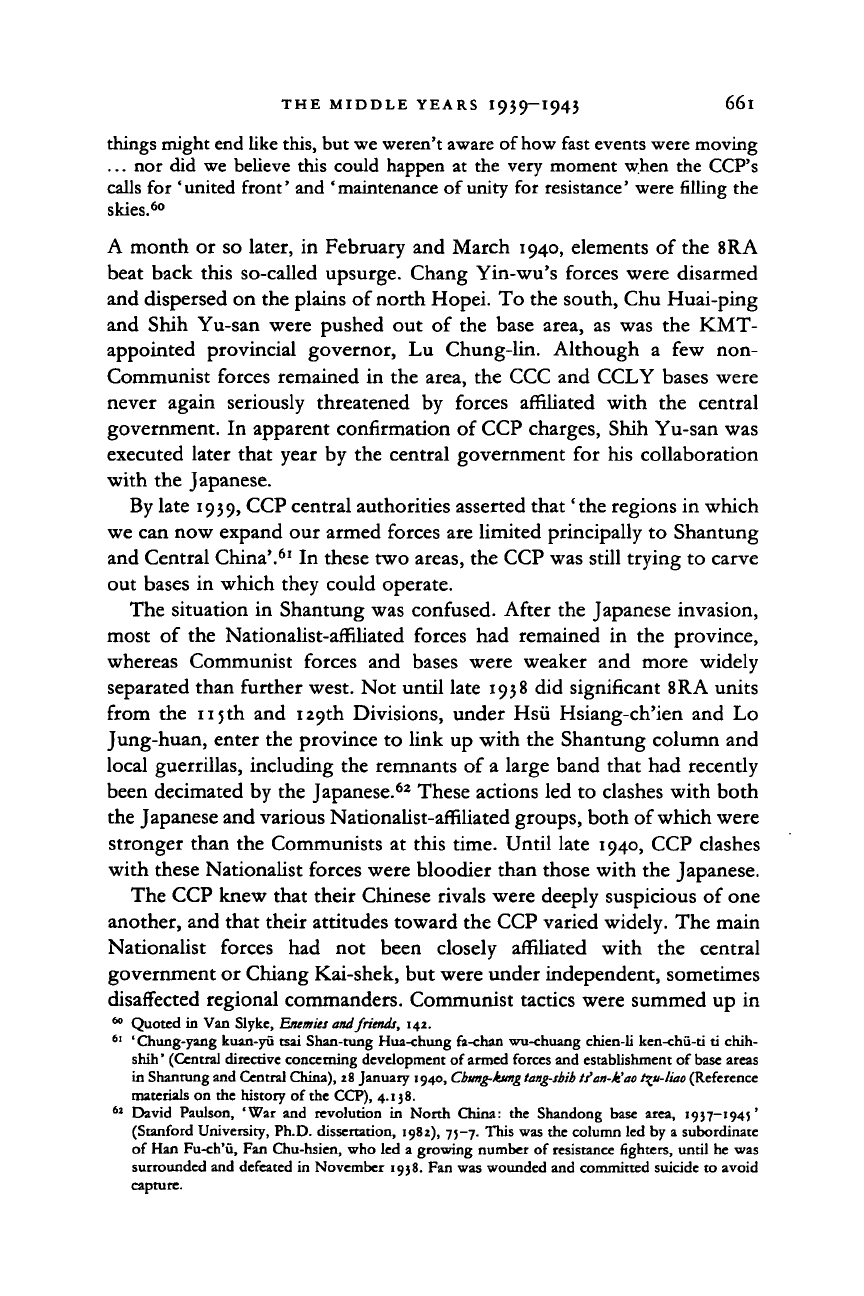
THE MIDDLE YEARS I939-I943 66l
things might end like this, but we weren't aware of how fast events were moving
... nor did we believe this could happen at the very moment when the CCP's
calls for 'united front* and 'maintenance of unity for resistance' were
filling
the
skies.
60
A month or so later, in February and March 1940, elements of the 8RA
beat back this so-called upsurge. Chang Yin-wu's forces were disarmed
and dispersed on the plains of north Hopei. To the south, Chu Huai-ping
and Shih Yu-san were pushed out of the base area, as was the KMT-
appointed provincial governor, Lu Chung-lin. Although a few non-
Communist forces remained in the area, the CCC and CCLY bases were
never again seriously threatened by forces affiliated with the central
government. In apparent confirmation of CCP charges, Shih Yu-san was
executed later that year by the central government for his collaboration
with the Japanese.
By late 1939, CCP central authorities asserted that 'the regions in which
we can now expand our armed forces are limited principally to Shantung
and Central China'.
61
In these two areas, the CCP was still trying to carve
out bases in which they could operate.
The situation in Shantung was confused. After the Japanese invasion,
most of the Nationalist-affiliated forces had remained in the province,
whereas Communist forces and bases were weaker and more widely
separated than further west. Not until late 1938 did significant 8RA units
from the 115th and 129th Divisions, under Hsu Hsiang-ch'ien and Lo
Jung-huan, enter the province to link up with the Shantung column and
local guerrillas, including the remnants of a large band that had recently
been decimated by the Japanese.
62
These actions led to clashes with both
the Japanese and various Nationalist-affiliated groups, both of which were
stronger than the Communists at this time. Until late 1940, CCP clashes
with these Nationalist forces were bloodier than those with the Japanese.
The CCP knew that their Chinese rivals were deeply suspicious of one
another, and that their attitudes toward the CCP varied widely. The main
Nationalist forces had not been closely affiliated with the central
government or Chiang Kai-shek, but were under independent, sometimes
disaffected regional commanders. Communist tactics were summed up in
60
Quoted
in
Van Slyke, Enemies and friends,
142.
61
'
Chung-yang kuan-yu tsai Shan-tung Hua-chung fa-chan wu-chuang chien-li ken-chu-ti
ti
chih-
shih' (Central directive concerning development
of
armed forces and establishment
of
base areas
in Shantung and Central China), 28 January 1940, Cbung-kjmg tang-sbib tian-k'ao t^u-liao (Reference
materials
on the
history
of
the CCP), 4.138.
62
David Paulson, 'War
and
revolution
in
North China:
the
Shandong base area, 1957-1945'
(Stanford University, Ph.D. dissertation, 1982), 75-7. This was the column led
by a
subordinate
of Han Fu-ch'u, Fan Chu-hsien, who
led a
growing number
of
resistance fighters, until
he was
surrounded and defeated
in
November 1938. Fan was wounded and committed suicide
to
avoid
capture.
Cambridge Histories Online © Cambridge University Press, 2008
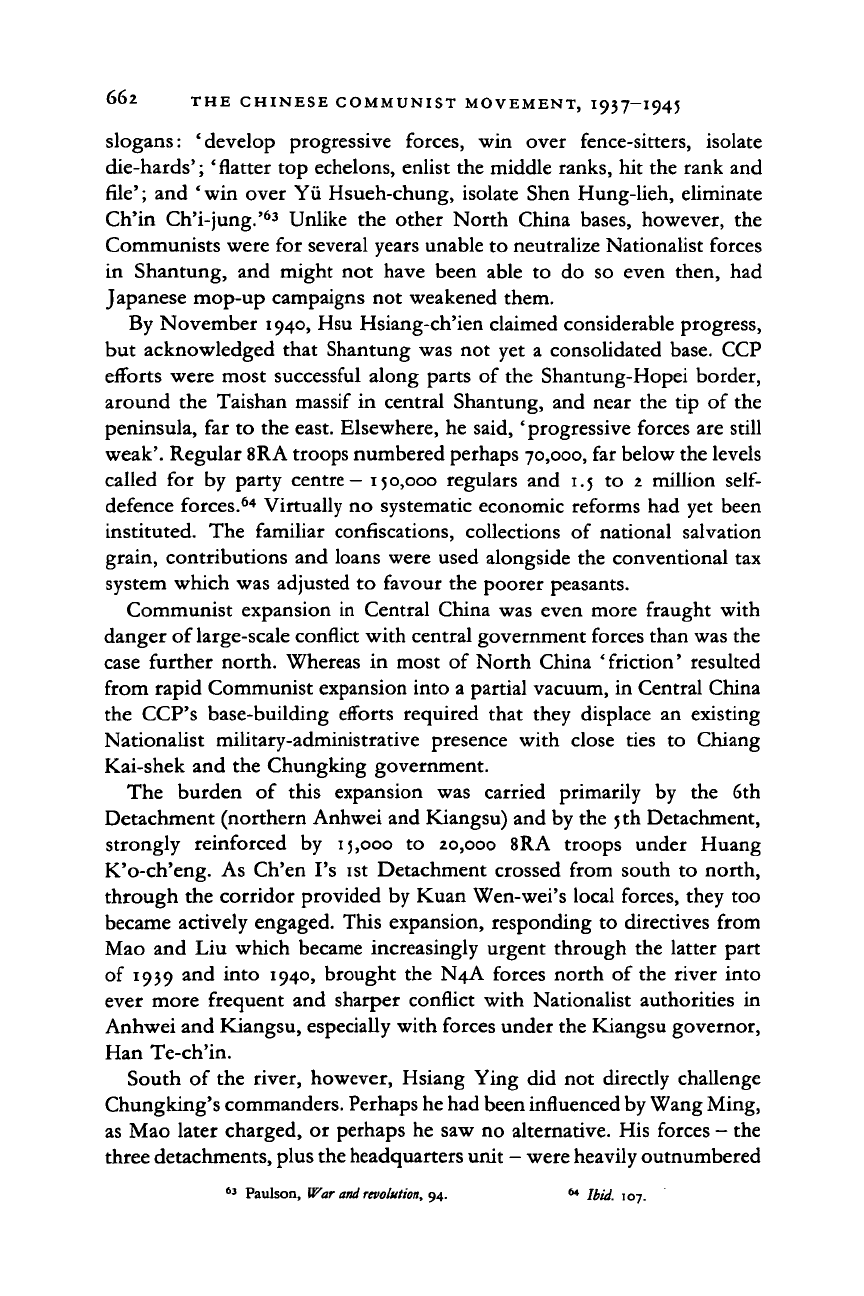
662 THE CHINESE COMMUNIST MOVEMENT, 1937-1945
slogans: 'develop progressive forces, win over fence-sitters, isolate
die-hards'; ' flatter top echelons, enlist the middle ranks, hit the rank and
file'; and 'win over Yu Hsueh-chung, isolate Shen Hung-lieh, eliminate
Ch'in Ch'i-jung.'
63
Unlike the other North China bases, however, the
Communists were for several years unable to neutralize Nationalist forces
in Shantung, and might not have been able to do so even then, had
Japanese mop-up campaigns not weakened them.
By November 1940, Hsu Hsiang-ch'ien claimed considerable progress,
but acknowledged that Shantung was not yet a consolidated base. CCP
efforts were most successful along parts of the Shantung-Hopei border,
around the Taishan massif in central Shantung, and near the tip of the
peninsula, far to the east. Elsewhere, he said, 'progressive forces are still
weak'. Regular 8RA troops numbered perhaps 70,000, far below the levels
called for by party centre
— 15
0,000 regulars and 1.5 to 2 million
self-
defence forces.
64
Virtually no systematic economic reforms had yet been
instituted. The familiar confiscations, collections of national salvation
grain, contributions and loans were used alongside the conventional tax
system which was adjusted to favour the poorer peasants.
Communist expansion in Central China was even more fraught with
danger of large-scale conflict with central government forces than was the
case further north. Whereas in most of North China ' friction' resulted
from rapid Communist expansion into a partial vacuum, in Central China
the CCP's base-building efforts required that they displace an existing
Nationalist military-administrative presence with close ties to Chiang
Kai-shek and the Chungking government.
The burden of this expansion was carried primarily by the 6th
Detachment (northern Anhwei and Kiangsu) and by the 5 th Detachment,
strongly reinforced by 15,000 to 20,000 8RA troops under Huang
K'o-ch'eng. As Ch'en I's 1st Detachment crossed from south to north,
through the corridor provided by Kuan Wen-wei's local forces, they too
became actively engaged. This expansion, responding to directives from
Mao and Liu which became increasingly urgent through the latter part
of 1939 and into 1940, brought the N4A forces north of the river into
ever more frequent and sharper conflict with Nationalist authorities in
Anhwei and Kiangsu, especially with forces under the Kiangsu governor,
Han Te-ch'in.
South of the river, however, Hsiang Ying did not directly challenge
Chungking's commanders. Perhaps he had been influenced by Wang Ming,
as Mao later charged, or perhaps he saw no alternative. His forces - the
three detachments, plus the headquarters unit
—
were heavily outnumbered
63
Paulson, War and
revolution,
94. *•
Ibid.
107.
Cambridge Histories Online © Cambridge University Press, 2008
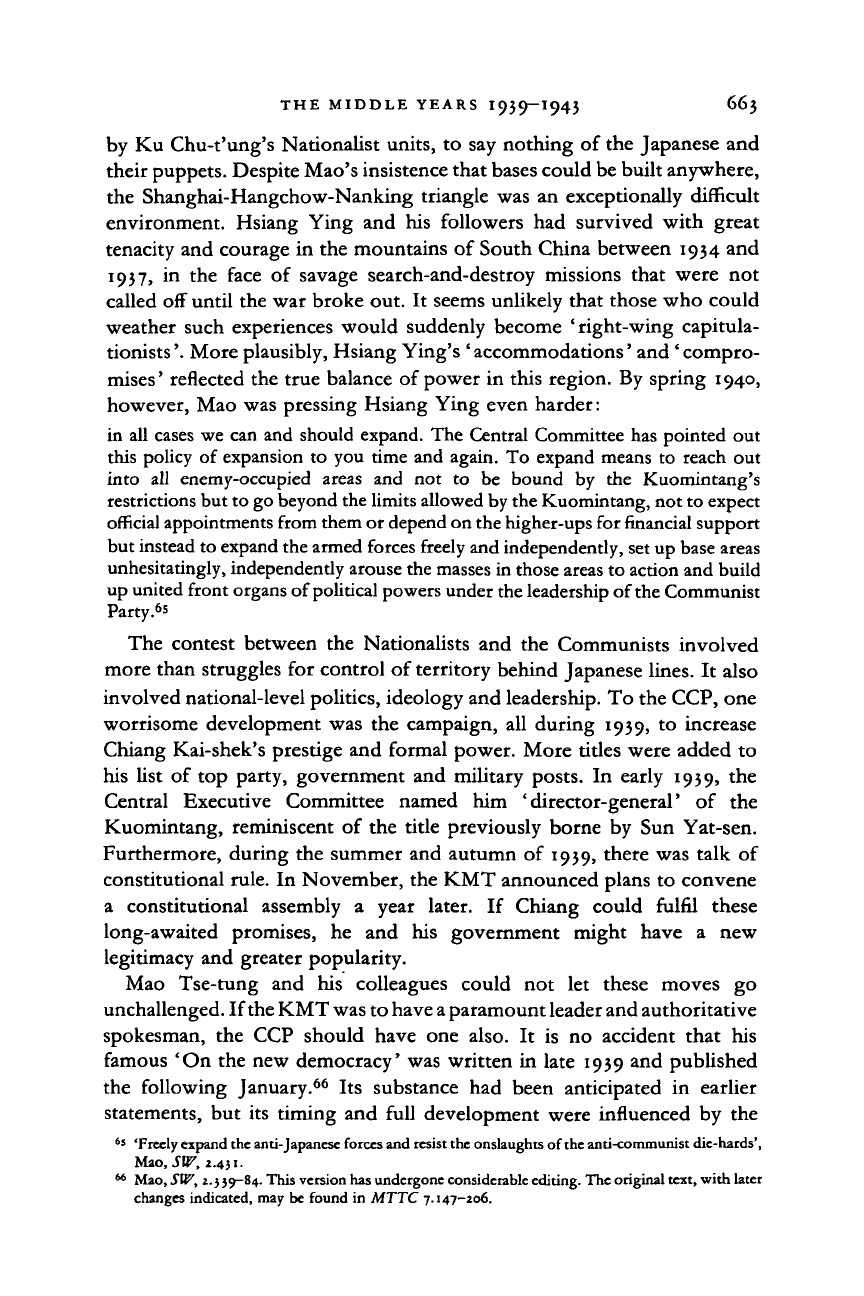
THE MIDDLE YEARS I939—I943 663
by Ku Chu-t'ung's Nationalist units, to say nothing of the Japanese and
their puppets. Despite Mao's insistence that bases could be built anywhere,
the Shanghai-Hangchow-Nanking triangle was an exceptionally difficult
environment. Hsiang Ying and his followers had survived with great
tenacity and courage in the mountains of South China between 1934 and
1937,
in the face of savage search-and-destroy missions that were not
called off until the war broke out. It seems unlikely that those who could
weather such experiences would suddenly become 'right-wing capitula-
tionists'. More plausibly, Hsiang Ying's
'
accommodations' and ' compro-
mises ' reflected the true balance of power in this region. By spring 1940,
however, Mao was pressing Hsiang Ying even harder:
in all cases we can and should expand. The Central Committee has pointed out
this policy of expansion to you time and again. To expand means to reach out
into all enemy-occupied areas and not to be bound by the Kuomintang's
restrictions but to
go
beyond the limits allowed
by
the Kuomintang, not to expect
ofHcial appointments from them or depend on the higher-ups for
financial
support
but instead to expand the armed forces freely and independently, set up base areas
unhesitatingly, independently arouse the masses in those areas to action and build
up united front organs of political powers under the leadership of the Communist
Party.
65
The contest between the Nationalists and the Communists involved
more than struggles for control of territory behind Japanese lines. It also
involved national-level politics, ideology and leadership. To the CCP, one
worrisome development was the campaign, all during 1939, to increase
Chiang Kai-shek's prestige and formal power. More titles were added to
his list of top party, government and military posts. In early 1939, the
Central Executive Committee named him 'director-general' of the
Kuomintang, reminiscent of the title previously borne by Sun Yat-sen.
Furthermore, during the summer and autumn of 1939, there was talk of
constitutional rule. In November, the KMT announced plans to convene
a constitutional assembly a year later. If Chiang could fulfil these
long-awaited promises, he and his government might have a new
legitimacy and greater popularity.
Mao Tse-tung and his colleagues could not let these moves go
unchallenged. If the KMT
was
to have
a
paramount leader and authoritative
spokesman, the CCP should have one also. It is no accident that his
famous 'On the new democracy' was written in late 1939 and published
the following January.
66
Its substance had been anticipated in earlier
statements, but its timing and full development were influenced by the
65
'Freely expand the anti-Japanese forces and resist the onslaughts of the anti-communist die-hards',
Mao,
SW,
2.431.
66
Mao,
SW,
2.339-84. This version has undergone considerable editing. The original text, with later
changes indicated, may
be
found
in
MTTC 7.147-206.
Cambridge Histories Online © Cambridge University Press, 2008

664 THE CHINESE COMMUNIST MOVEMENT, 1937-1945
KMT constitutional movement. It was the CCP's entry in the competition,
both a bid for support (away from the KMT) and a statement of the
multiclass united front coalition the CCP desired to lead. The apparently
temperate and moderate tone of'On the new democracy' persuaded many
Chinese that the CCP had either diluted its revolutionary objectives or
had deferred them to a distant future. But here, as in so many other CCP
statements, language was used on two levels of meaning. To those in
Kuomintang-controlled areas, the text invited an interpretation according
to the liberal values of Anglo-American democracy: popular participation,
multi-party government, legally protected civil rights. But in the
territories the CCP controlled, the same words had more authoritarian,
class-based connotations. In classified inner-party documents not for
public consumption the ambiguity was dropped, and one can see clearly
the tough, patient and flexible commitment of the party not only to
resistance but also to social control and social change.
During this same period, the Communists professed a deep concern
over the danger of Nationalist capitulation to Japan, not only on the
battlefields behind Japanese lines, but at the highest levels. To be sure,
some of this was propaganda, but behind the propaganda was genuine
worry. During late 1939 and early 1940, all politically aware Chinese knew
that Japan was negotiating with the mercurial Wang Chang-wei, who had
fled Chungking a year earlier. A 'reorganized national government' in
Nanking was finally established in March 1940, the most formidable
collaboration to date.
Less well known was that, at the same time, the Japanese were seeking
an understanding with Chiang Kai-shek
himself,
through intermediaries
in Hong Kong. 'Operation Kiri', as this effort to 'spread a feast for
Chiang' was called, had elements of both high intrigue and low comedy.
Chiang's reported interest in peace may have been a hoax designed to
further discredit Wang Ching-wei, who was kept waiting in the wings
until Operation Kiri had fallen through, but even if Chiang had no
intention of coming to terms with the Japanese, the Communists could
not be sure of the outcome of this multi-pronged peace offensive until
after its failure.
Never had China been so isolated as she was by the middle of 1940. In
Europe, the' phony war' ended in the spring with the German blitz across
the Low Countries. France was soon knocked out, and England seemed
likely to fall. Japan took advantage of the situation to demand the
severance of China's last tenuous links with the outside world: the Burma
Road, trade with neutral Hong Kong, and the railway line from Hanoi
to Kunming. Meanwhile Russia was engaged in a nasty and embarrassing
war with Finland and was cutting back on its military aid to the
Cambridge Histories Online © Cambridge University Press, 2008
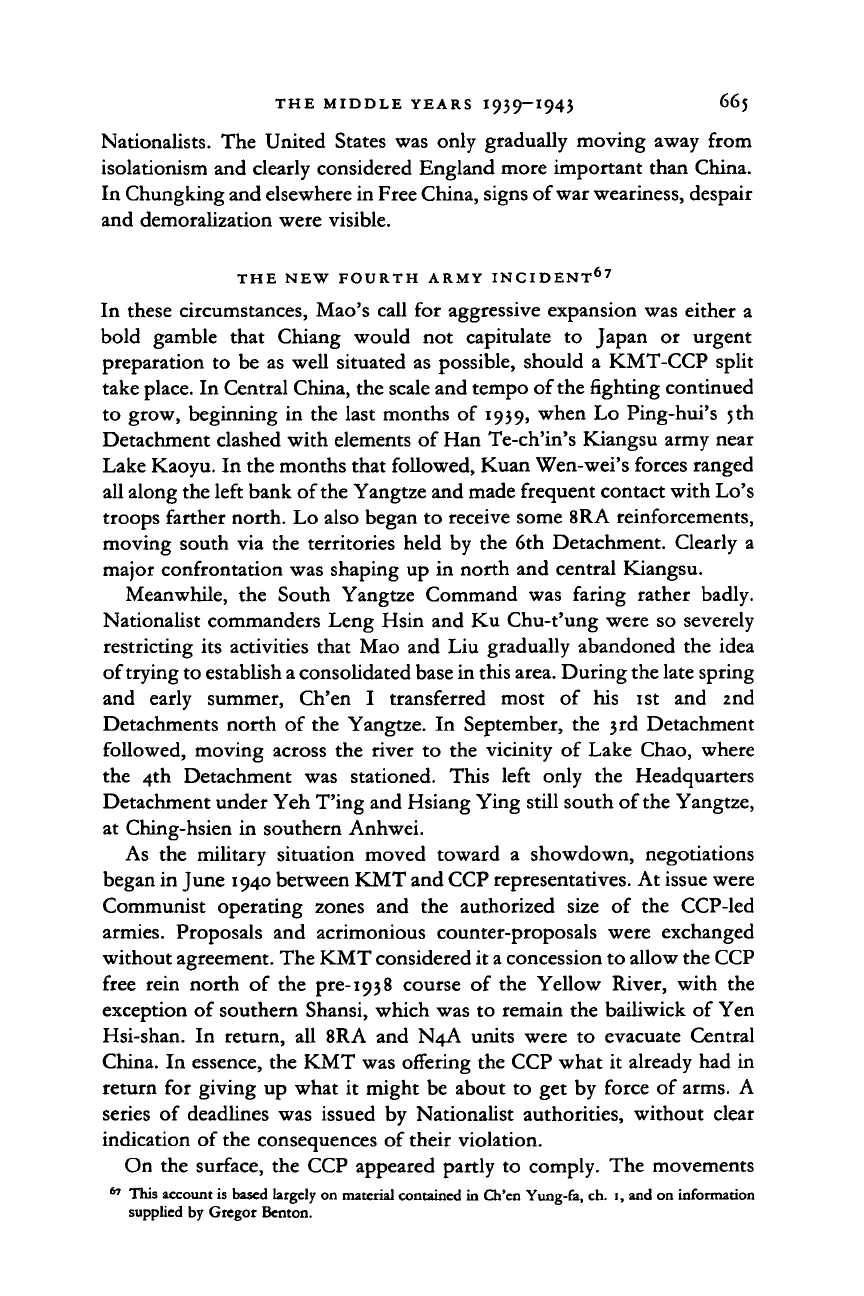
THE MIDDLE YEARS I939-I943 665
Nationalists. The United States was only gradually moving away from
isolationism and clearly considered England more important than China.
In Chungking and elsewhere in Free China, signs of war weariness, despair
and demoralization were visible.
THE NEW FOURTH ARMY INCIDENT
67
In these circumstances, Mao's call for aggressive expansion was either a
bold gamble that Chiang would not capitulate to Japan or urgent
preparation to be as well situated as possible, should a KMT-CCP split
take place. In Central China, the scale and tempo of the righting continued
to grow, beginning in the last months of 1939, when Lo Ping-hui's 5th
Detachment clashed with elements of Han Te-ch'in's Kiangsu army near
Lake Kaoyu. In the months that followed, Kuan Wen-wei's forces ranged
all along the left bank of the Yangtze and made frequent contact with Lo's
troops farther north. Lo also began to receive some 8RA reinforcements,
moving south via the territories held by the 6th Detachment. Clearly a
major confrontation was shaping up in north and central Kiangsu.
Meanwhile, the South Yangtze Command was faring rather badly.
Nationalist commanders Leng Hsin and Ku Chu-t'ung were so severely
restricting its activities that Mao and Liu gradually abandoned the idea
of trying to establish a consolidated base in this area. During the late spring
and early summer, Ch'en I transferred most of his 1st and 2nd
Detachments north of the Yangtee. In September, the 3rd Detachment
followed, moving across the river to the vicinity of Lake Chao, where
the 4th Detachment was stationed. This left only the Headquarters
Detachment under Yeh T'ing and Hsiang Ying still south of
the
Yangtze,
at Ching-hsien in southern Anhwei.
As the military situation moved toward a showdown, negotiations
began in June 1940 between KMT and CCP representatives. At issue were
Communist operating zones and the authorized size of the CCP-led
armies. Proposals and acrimonious counter-proposals were exchanged
without agreement. The KMT considered it
a
concession to allow the CCP
free rein north of the pre-1938 course of the Yellow River, with the
exception of southern Shansi, which was to remain the bailiwick of Yen
Hsi-shan. In return, all 8RA and N4A units were to evacuate Central
China. In essence, the KMT was offering the CCP what it already had in
return for giving up what it might be about to get by force of arms. A
series of deadlines was issued by Nationalist authorities, without clear
indication of the consequences of their violation.
On the surface, the CCP appeared partly to comply. The movements
67
This account is based largely on material contained in Ch'en Yung-fo, ch. i, and on information
supplied by Gregot Benton.
Cambridge Histories Online © Cambridge University Press, 2008
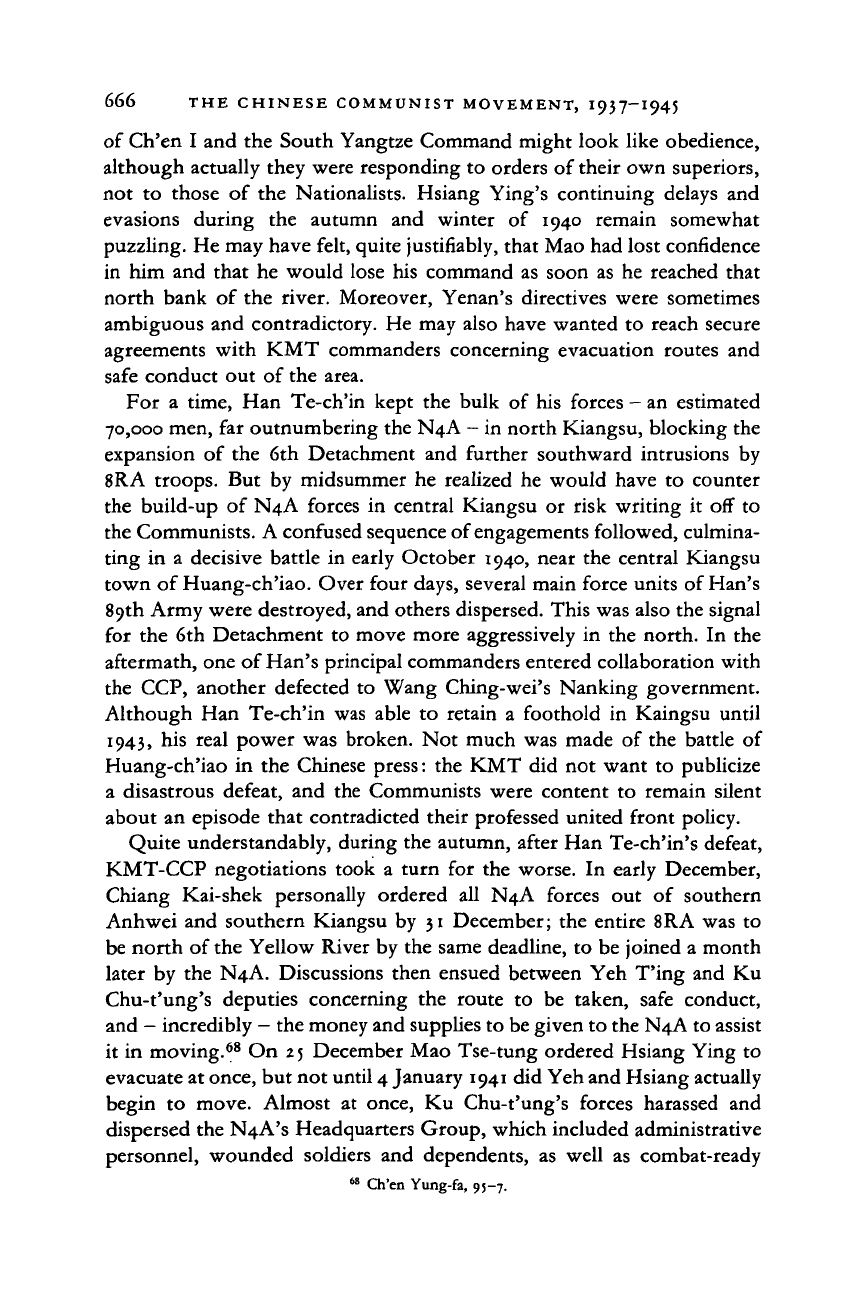
666 THE CHINESE COMMUNIST MOVEMENT, I937-I945
of Ch'en I and the South Yangtze Command might look like obedience,
although actually they were responding to orders of their own superiors,
not to those of the Nationalists. Hsiang Ying's continuing delays and
evasions during the autumn and winter of 1940 remain somewhat
puzzling. He may have felt, quite justifiably, that Mao had lost confidence
in him and that he would lose his command as soon as he reached that
north bank of the river. Moreover, Yenan's directives were sometimes
ambiguous and contradictory. He may also have wanted to reach secure
agreements with KMT commanders concerning evacuation routes and
safe conduct out of the area.
For a time, Han Te-ch'in kept the bulk of his forces
—
an estimated
70,000 men, far outnumbering the N4A
—
in north Kiangsu, blocking the
expansion of the 6th Detachment and further southward intrusions by
8RA troops. But by midsummer he realized he would have to counter
the build-up of N4A forces in central Kiangsu or risk writing it off to
the Communists. A confused sequence of engagements followed, culmina-
ting in a decisive battle in early October 1940, near the central Kiangsu
town of Huang-ch'iao. Over four days, several main force units of Han's
89th Army were destroyed, and others dispersed. This was also the signal
for the 6th Detachment to move more aggressively in the north. In the
aftermath, one of Han's principal commanders entered collaboration with
the CCP, another defected to Wang Ching-wei's Nanking government.
Although Han Te-ch'in was able to retain a foothold in Kaingsu until
1943,
his real power was broken. Not much was made of the battle of
Huang-ch'iao in the Chinese press: the KMT did not want to publicize
a disastrous defeat, and the Communists were content to remain silent
about an episode that contradicted their professed united front policy.
Quite understandably, during the autumn, after Han Te-ch'in's defeat,
KMT-CCP negotiations took a turn for the worse. In early December,
Chiang Kai-shek personally ordered all N4A forces out of southern
Anhwei and southern Kiangsu by 31 December; the entire 8RA was to
be north of the Yellow River by the same deadline, to be joined a month
later by the N4A. Discussions then ensued between Yeh T'ing and Ku
Chu-t'ung's deputies concerning the route to be taken, safe conduct,
and - incredibly - the money and supplies to be given to the N4A to assist
it in moving.
68
On
2 5
December Mao Tse-tung ordered Hsiang Ying to
evacuate at once, but not until 4 January 1941 did Yeh and Hsiang actually
begin to move. Almost at once, Ku Chu-t'ung's forces harassed and
dispersed the N4A's Headquarters Group, which included administrative
personnel, wounded soldiers and dependents, as well as combat-ready
68
Ch'en Yung-fa, 95-7.
Cambridge Histories Online © Cambridge University Press, 2008
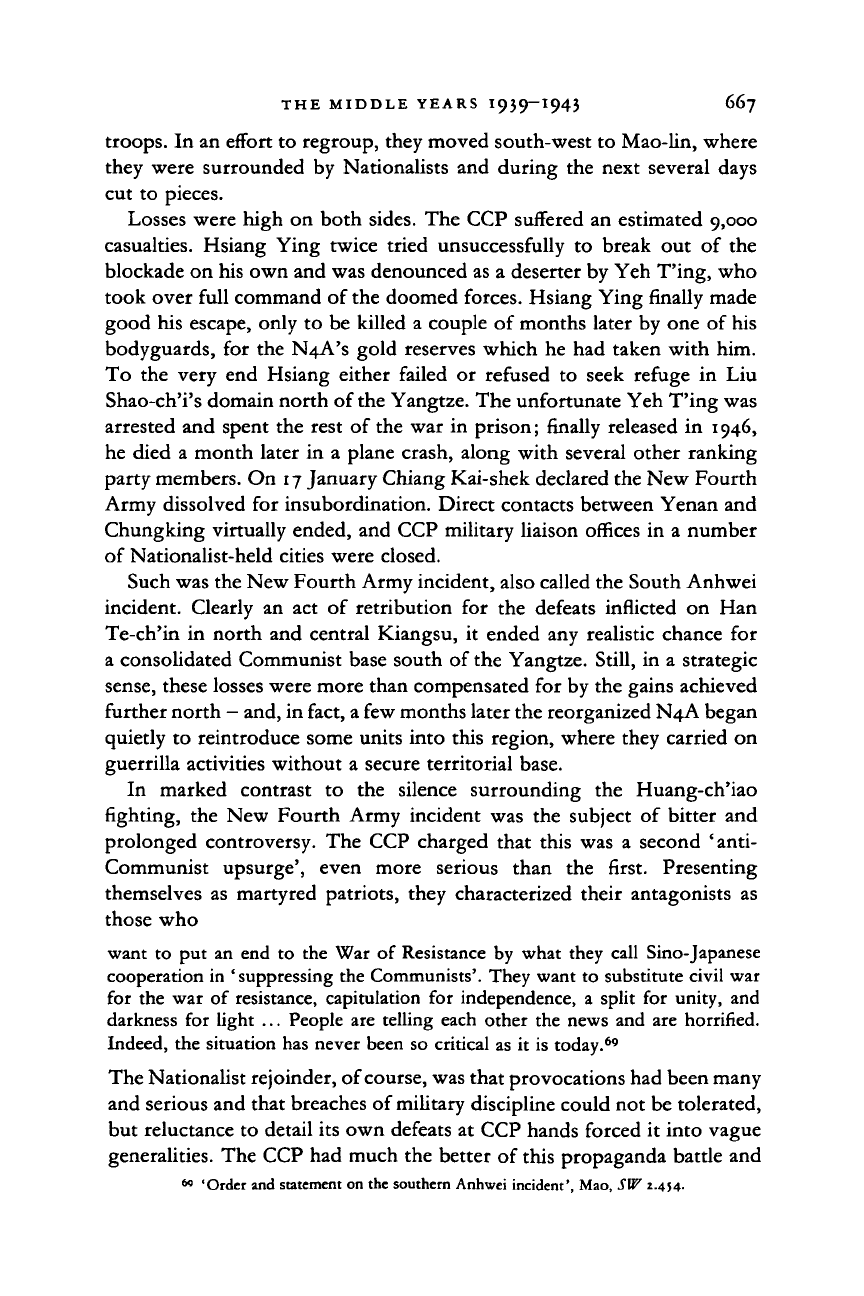
THE MIDDLE YEARS I939-I943 667
troops. In an effort to regroup, they moved south-west to Mao-lin, where
they were surrounded by Nationalists and during the next several days
cut to pieces.
Losses were high on both sides. The CCP suffered an estimated 9,000
casualties. Hsiang Ying twice tried unsuccessfully to break out of the
blockade on his own and was denounced as a deserter by Yeh T'ing, who
took over full command of the doomed forces. Hsiang Ying finally made
good his escape, only to be killed a couple of months later by one of his
bodyguards, for the N4A's gold reserves which he had taken with him.
To the very end Hsiang either failed or refused to seek refuge in Liu
Shao-ch'i's domain north of the Yangtze. The unfortunate Yeh T'ing was
arrested and spent the rest of the war in prison; finally released in 1946,
he died a month later in a plane crash, along with several other ranking
party members. On
17
January Chiang Kai-shek declared the New Fourth
Army dissolved for insubordination. Direct contacts between Yenan and
Chungking virtually ended, and CCP military liaison offices in a number
of Nationalist-held cities were closed.
Such was the New Fourth Army incident, also called the South Anhwei
incident. Clearly an act of retribution for the defeats inflicted on Han
Te-ch'in in north and central Kiangsu, it ended any realistic chance for
a consolidated Communist base south of the Yangtze. Still, in a strategic
sense, these losses were more than compensated for by the gains achieved
further north - and, in fact, a few months later the reorganized N4A began
quietly to reintroduce some units into this region, where they carried on
guerrilla activities without a secure territorial base.
In marked contrast to the silence surrounding the Huang-ch'iao
fighting, the New Fourth Army incident was the subject of bitter and
prolonged controversy. The CCP charged that this was a second 'anti-
Communist upsurge', even more serious than the first. Presenting
themselves as martyred patriots, they characterized their antagonists as
those who
want to put an end to the War of Resistance by what they call Sino-Japanese
cooperation in 'suppressing the Communists'. They want to substitute civil war
for the war of resistance, capitulation for independence, a split for unity, and
darkness for light ... People are telling each other the news and are horrified.
Indeed, the situation has never been so critical as it is today.
69
The Nationalist rejoinder, of course, was that provocations had been many
and serious and that breaches of military discipline could not be tolerated,
but reluctance to detail its own defeats at CCP hands forced it into vague
generalities. The CCP had much the better of this propaganda battle and
65
'Order and statement on the southern Anhwei incident', Mao, SW 2.454.
Cambridge Histories Online © Cambridge University Press, 2008
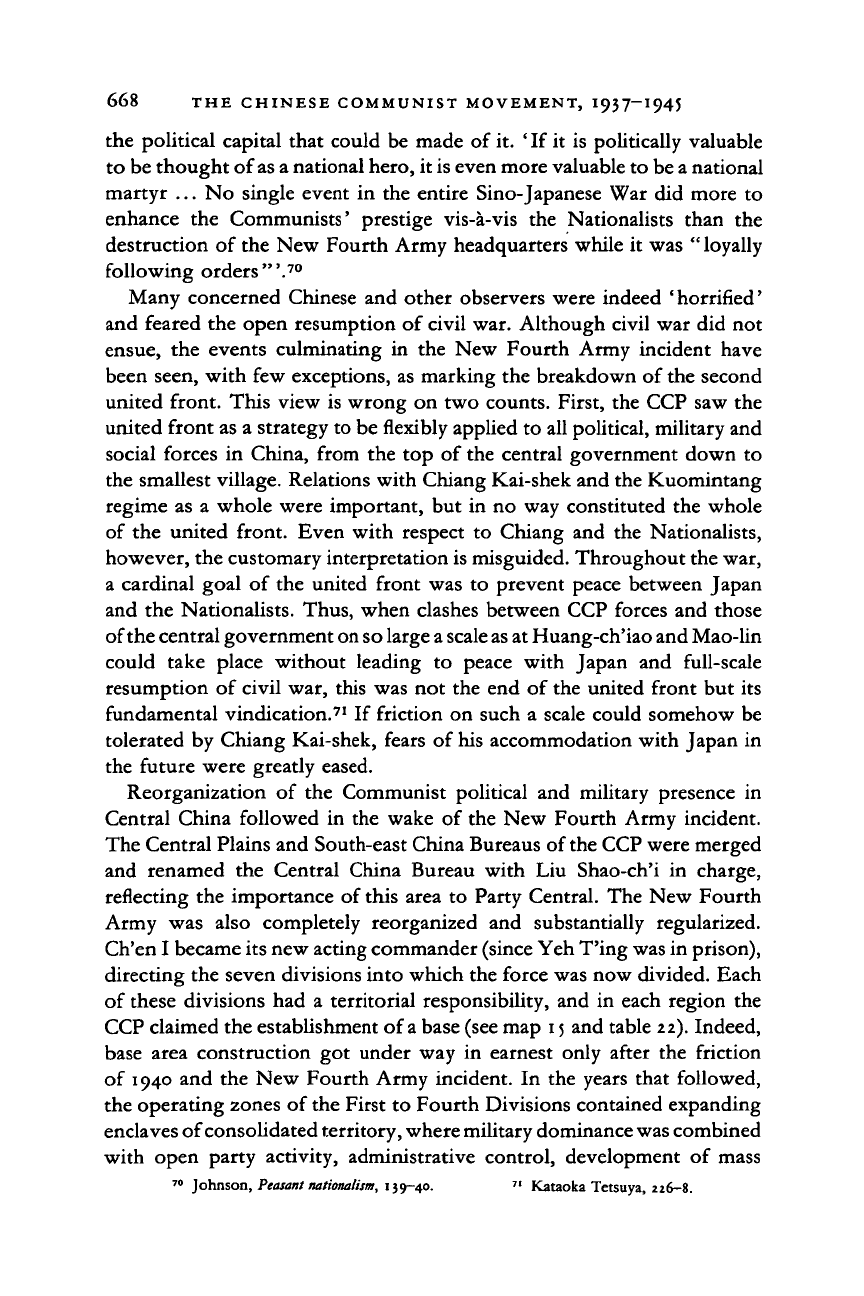
668 THE CHINESE COMMUNIST MOVEMENT, I937-I945
the political capital that could be made of it. ' If it is politically valuable
to be thought of as a national hero, it is even more valuable to be a national
martyr ... No single event in the entire Sino-Japanese War did more to
enhance the Communists' prestige vis-a-vis the Nationalists than the
destruction of the New Fourth Army headquarters while it was " loyally
following orders"'.
70
Many concerned Chinese and other observers were indeed 'horrified'
and feared the open resumption of civil war. Although civil war did not
ensue, the events culminating in the New Fourth Army incident have
been seen, with few exceptions, as marking the breakdown of the second
united front. This view is wrong on two counts. First, the CCP saw the
united front as a strategy to be flexibly applied to all political, military and
social forces in China, from the top of the central government down to
the smallest village. Relations with Chiang Kai-shek and the Kuomintang
regime as a whole were important, but in no way constituted the whole
of the united front. Even with respect to Chiang and the Nationalists,
however, the customary interpretation is misguided. Throughout the war,
a cardinal goal of the united front was to prevent peace between Japan
and the Nationalists. Thus, when clashes between CCP forces and those
of the central government on so large
a
scale
as
at Huang-ch'iao and Mao-lin
could take place without leading to peace with Japan and full-scale
resumption of civil war, this was not the end of the united front but its
fundamental vindication.
71
If friction on such a scale could somehow be
tolerated by Chiang Kai-shek, fears of his accommodation with Japan in
the future were greatly eased.
Reorganization of the Communist political and military presence in
Central China followed in the wake of the New Fourth Army incident.
The Central Plains and South-east China Bureaus of
the
CCP were merged
and renamed the Central China Bureau with Liu Shao-ch'i in charge,
reflecting the importance of this area to Party Central. The New Fourth
Army was also completely reorganized and substantially regularized.
Ch'en I became its new acting commander (since Yeh T'ing was in prison),
directing the seven divisions into which the force was now divided. Each
of these divisions had a territorial responsibility, and in each region the
CCP claimed the establishment of
a
base (see map 15 and table 22). Indeed,
base area construction got under way in earnest only after the friction
of 1940 and the New Fourth Army incident. In the years that followed,
the operating zones of the First to Fourth Divisions contained expanding
enclaves of consolidated territory, where military dominance
was
combined
with open party activity, administrative control, development of mass
70
Johnson, Peasant nationalism, 139-40.
7I
Kataoka Tetsuya, 226-8.
Cambridge Histories Online © Cambridge University Press, 2008
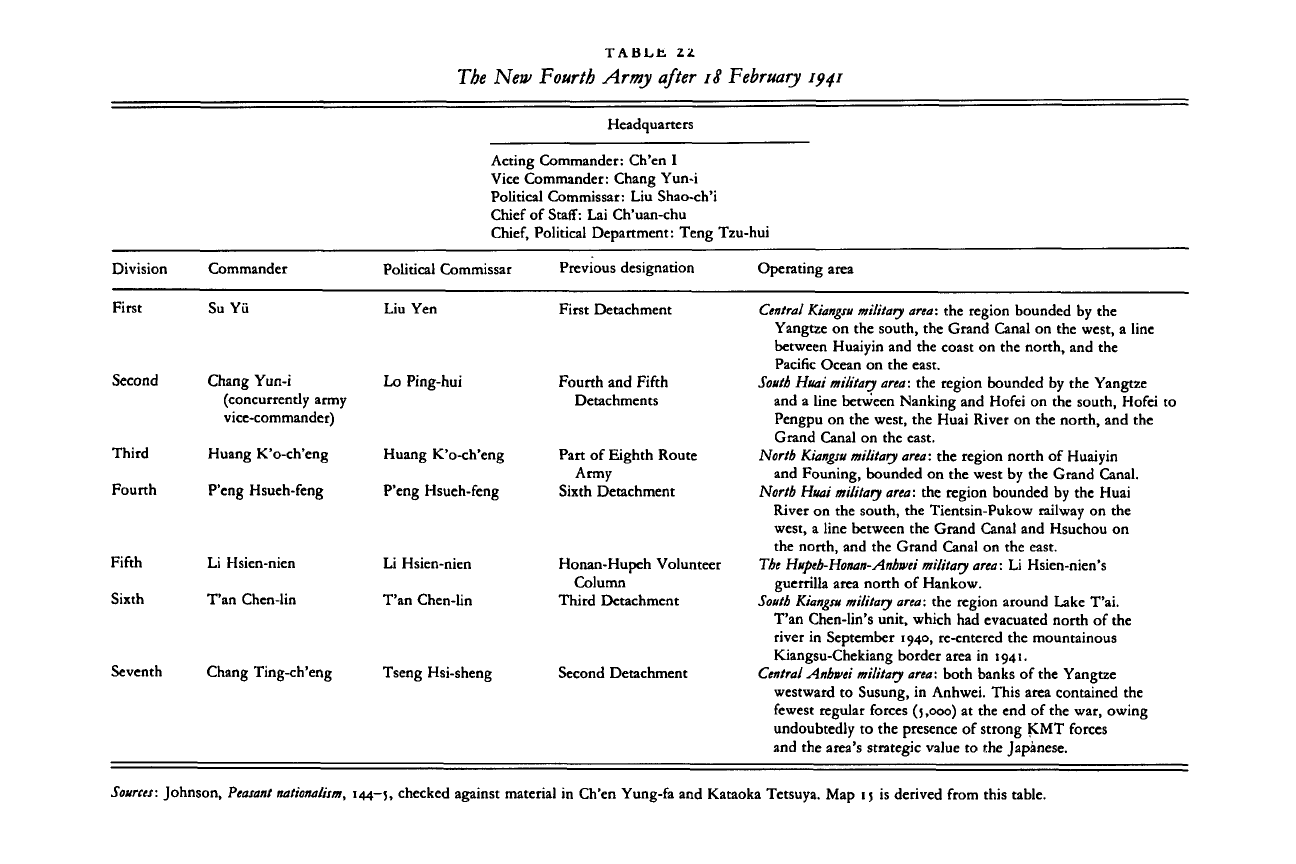
TABLt
ZZ
The
New
Fourth Army after
18
February 1941
Headquarters
Acting Commander: Ch'en
I
Vice Commander: Chang Yun-i
Political Commissar:
Liu
Shao-ch'i
Chief
of Staff: Lai
Ch'uan-chu
Chief,
Political Department: Teng Tzu-hui
Division Commander Political Commissar
Previous designation Operating area
rirst
Second
Third
Fourth
Fifth
Sixth
Seventh
Su
Yu
Chang Yun-i
(concurrently army
vice-commander)
Huang K'o-ch'eng
P'eng Hsueh-feng
Li Hsien-nien
T'an Chen-lin
Chang Ting-ch'eng
Liu
Yen
Lo Ping-hui
Huang K'o-ch'eng
P'eng Hsueh-feng
Li Hsien-nien
T'an Chen-lin
Tseng Hsi-sheng
First Detachment
Fourth
and
Fifth
Detachments
Part
of
Eighth Route
Army
Sixth Detachment
Honan-Hupeh Volunteer
Column
Third Detachment
Second Detachment
Central Kiangsu military
area:
the
region bounded
by the
Yangtze
on the
south,
the
Grand Canal
on the
west,
a
line
between Huaiyin
and the
coast
on the
north,
and the
Pacific Ocean
on the
east.
South
Huai
military
area:
the
region bounded
by the
Yangtze
and
a
line between Nanking
and
Hofei
on the
south, Hofei
to
Pengpu
on the
west,
the
Huai River
on the
north,
and the
Grand Canal
on the
east.
North
Kiangsu military
area:
the
region north
of
Huaiyin
and Founing, bounded
on the
west
by the
Grand Canal.
North Huai
military
area:
the
region bounded
by the
Huai
River
on the
south,
the
Tientsin-Pukow railway
on the
west,
a
line between
the
Grand Canal
and
Hsuchou
on
the north,
and the
Grand Canal
on the
east.
The
Hupeb-Honan-Anhwei military
area:
Li
Hsien-nien's
guerrilla area north
of
Hankow.
South Kiangsu military
area:
the
region around Lake
T'ai.
T'an Chen-lin's unit, which
had
evacuated north
of the
river
in
September
1940,
re-entered
the
mountainous
Kiangsu-Chekiang border area
in 1941.
Central Anbwei military
area:
both banks
of the
Yangtze
westward
to
Susung,
in
Anhwei. This area contained
the
fewest regular forces (5,000)
at the end of the war,
owing
undoubtedly
to the
presence
of
strong
KMT
forces
and
the
area's strategic value
to the
Japanese.
Sources:
Johnson,
Peasant
nationalism,
144-5, checked against material
in
Ch'en Yung-fa
and
Kataoka Tetsuya.
Map IJ is
derived from this table.
Cambridge Histories Online © Cambridge University Press, 2008
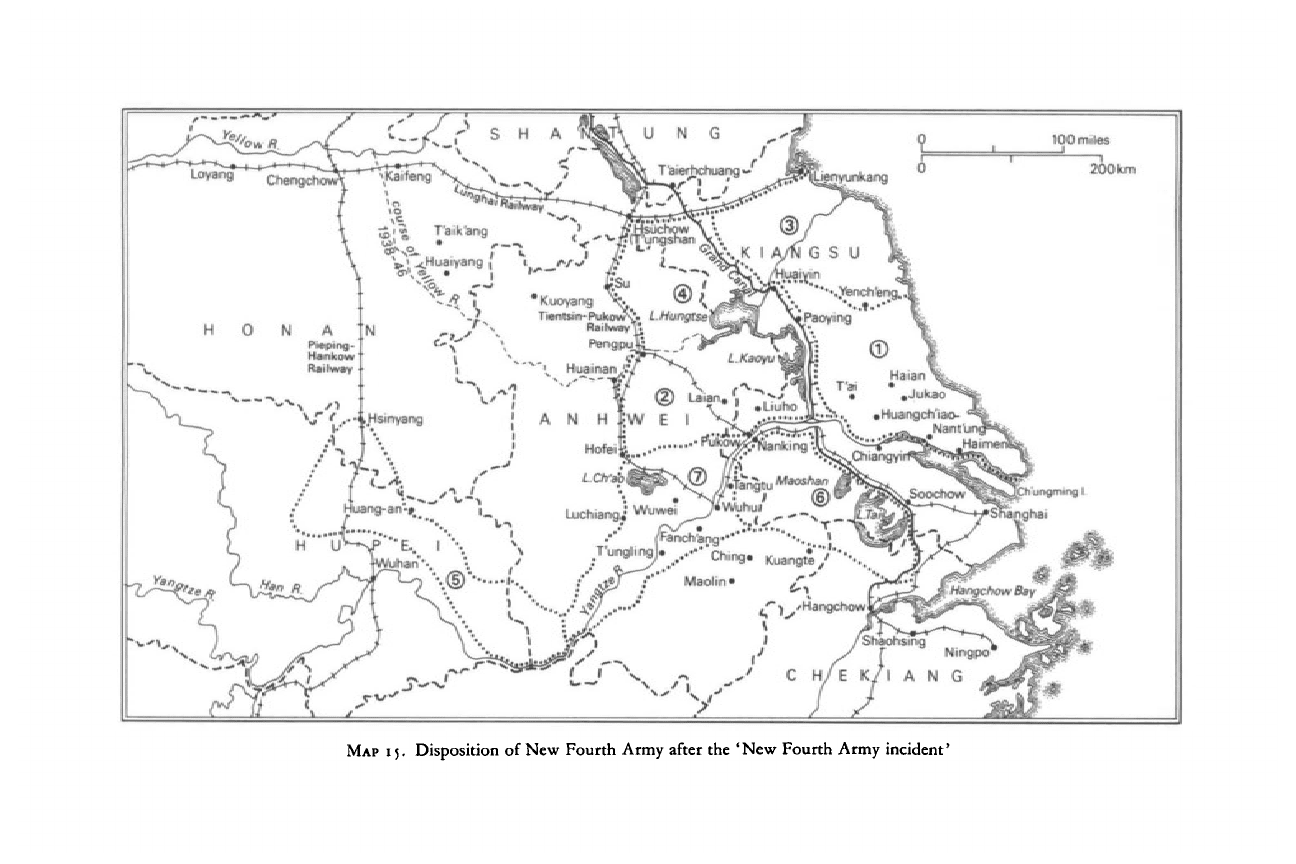
100 miles
*
Kuoyang
N
Tientsin-Pukovv^* L.Hungtse
Railw
Peng
uang-an-f
i
c
H/E K/I A N G
200 km
MAP
15. Disposition of New Fourth Army after the 'New Fourth Army incident'
Cambridge Histories Online © Cambridge University Press, 2008
